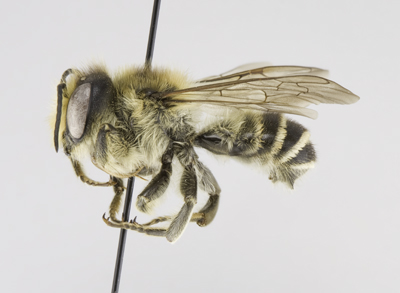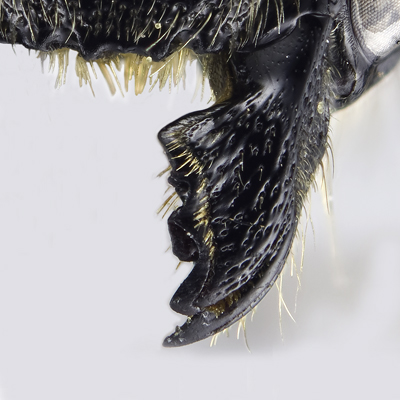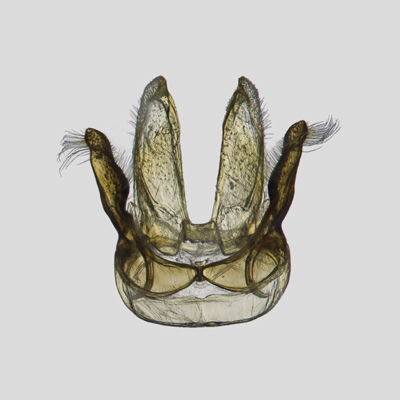
15. Megachile (Megachile) inermis Provancher, 1888
Megachile inermis Female |
Megachile inermis Male |
Megachile simplex Provancher, 1882. Nat. Canad. 13: 229. (♂) (preoccupied).
Megachile inermis Provancher, 1888. Addit. Corr. Faune Entomol. Canada, Hym. pg. 323 (♂).
Megachile simplicissima Dalla Torre, 1896. Cat. Hym. 10: 449 (replacement name for M. simplex Provancher, 1882, not Smith, 1853).
Megachile sapellonis Cockerell, 1900. Ann. Mag. Nat. Hist. (7) 6: 7 (♀).
Megachile temporalis Friese, 1903. Ztschr. System. Hym. Dipt. 3: 247 (♂) (♀ misdetermination).
Megachile decipiens Lovell and Cockerell, 1907. Psyche 14: 19 (♂).
Diagnosis.The female of M. inermis can be recognized by the combination of 5-dentate mandibles with an incomplete cutting edge between 2nd and 3rd teeth, clypeal margin with a slight but rather broad median protuberance, broad vertex, the gena being wider than the compound eye, and the entirely pale scopa. They are most similar to M. centuncularis, M. lapponica and M. relativa, all of which have the lateral ocelli nearer margin of vertex than eyes. The male can be recognized by the combination of simple and dark front tarsi, front coxal spine represented by a low dentiform tubercle that is hidden by pubescence, 3-dentate mandibles with the 2nd tooth much nearer the apical tooth than the 3rd tooth. They are most similar to M. montivaga. Males of M. montivaga have mandibles with three equally spaced teeth.
FEMALE: Length 15-20 mm.
Head:
Figure M15: Megachile inermis female mandible |
1) compound eyes parallel to slightly converging below; lateral ocelli considerably nearer eyes than margin of the very broad vertex (10:7), 2) clypeal margin with a slight but rather broad median protuberance delineated by a narrow but rather deep semicircular emargination on each side, with small sublateral tubercles; margin at extreme sides with an oblique, subapical groove beyond which the surface is shining and impunctate, 3) mandibles 5-dentate, with an incomplete cutting edge between the 2nd and 3rd teeth (Figure M15), 4) gena wider than compound eye (4:3), 5) vertex shining, punctures shallow but distinct, variable in size, rather close medially, becoming more sparse laterally, especially between ocelli and eyes; punctures on gena minute, slightly separated and quite evenly distributed; frons rather coarsely rugosopunctate, supraclypeal area and clypeus shining and sparsely punctate medially, punctures becoming rather close and quite deep on lateral margins, 6) pubescence sparse, not at all obscuring the surface, most dense around antennae and lower paraocular area, elongate and pale on gena below, but still rather sparse, becoming shorter and sparser above, with erect and elongate black hairs on vertex, between ocelli, and to some degree between antennae, 7) F1 longer than broad (3:2), about twice as long as pedicel, subequal in length to remaining flagellomeres, apical flagellomere more elongate, twice as long as broad.
Mesosoma:
1) pubescence pale and rather dense laterally and posteriorly; mesoscutum and scutellum with shorter but erect and conspicuous black pubescence, becoming pale peripherally, 2) mesoscutum with punctures quite deep and distinct with very small interspaces, becoming densely crowded laterally and anteriorly; scutellum rather dull, punctures closely crowded and rather fine, very fine and dense on axilla; pleura somewhat shining below between fine and close but slightly separated punctures, these becoming very fine and quite densely crowded above; propodeum somewhat more shining and smooth, punctures fine and close, triangle somewhat shiny and impunctate, 3) front coxa with a small but distinct tubercle; mid and hind basitarsi somewhat shorter and narrower than their tibiae, spurs reddish, 4) tegula somewhat shining, smooth and impunctate in large part, but with some very minute, rather close punctures anteriorly and on inner sides, 5) wings subhyaline, veins yellowish-brown.
Metasoma:
1) T2-T5 with complete but rather shallow subbasal grooves, basal margins quite distinct and somewhat carinate, apical margins of terga narrowly depressed, whitish fasciate, the fasciae more or less interrupted on the more basal terga, pubescence of T1 elongate and rather copious, entirely whitish, discs of following terga with short but erect, rather conspicuous hairs, these blackish on each disc apically, to some degree pale toward base, punctures very fine or minute, slightly separated, rather obscure, becoming slightly coarser and closer at extreme sides; T6 nearly straight in profile, with short, largely black suberect hairs, surface very densely and finely punctate and rather densely covered with very fine appressed dark tomentum that does not hide surface, 2) S6 well covered with pale scopal hairs, with a dense, apical fringe of very short hairs; scopa otherwise pale yellowish, the sterna closely and deeply punctate, finely so on the more basal segments, becoming rather coarse apically, apical margins narrowly yellowish-hyaline.
MALE: Length 11-15 mm.
Head:
1) compound eyes subparallel; lateral ocelli much nearer eyes than margin of the very broad vertex, 2) clypeal margin nearly straight, with a very slight, median protuberance, densely covered with elongate, pale hairs, margin at extreme sides with an oblique, subapical groove beyond which the surface is shining and impunctate, 3) mandible 3-dentate, distance from the apex of the middle tooth to the apex of inner tooth nearly twice as great as that to the apical tooth, lower process elongate, rather broadly carinate, subbasal in position; 4) gena wider than compound eye (5:4), 5) punctures of vertex rather fine and shallow, quite close medially, becoming rather well separated and irregular between eyes and ocelli, close and fine on gena, frons more closely rugosopunctate, punctures becoming very fine and densely crowded on supraclypeal area, somewhat finer and crowded over most of clypeus, excluding the lateral areas of apical edge, which is shiny and impunctate, 6) pubescence quite copious, dense and elongate around antennae and over lower part of face, on gena below, becoming somewhat sparser but still quite elongate on vertex, with a few dark hairs intermixed with generally pale pubescence on vertex, 7) F1 longer than broad (3:2.5), about twice as long as pedicel, shorter than remaining flagellomeres, which are longer than broad (3.5:2), apical flagellomere more elongate, twice as long as broad.
Mesosoma:
1) pubescence quite copious, dense and elongate laterally and posteriorly, becoming somewhat sparcer but still quite elongate dorsally, with a few dark hairs intermixed with generally pale pubescence of mesoscutum, 2) punctures rather fine and close over most of mesoscutum, densely crowded elsewhere; very fine and densely crowded on axilla; pleura rather smooth, punctures very fine and quite close; propodeum somewhat smoother but rather dull, with fine and close punctures, surface largely obscured by pubescence, triangle somewhat shiny and impunctate, 3) coxal spine represented by a low dentiform tubercle that is hidden by pubescence; all basitarsi much shorter and narrower than their tibiae, the apical tarsomeres becoming more or less reddish; spurs yellowish-brown, mid tibial spur short but well developed, outer tarsal claws much more rounded than the inner ones, which are pointed, 4) tegula shining, with sparse irregular minute punctures, 5) wings subhyaline, veins yellowish-brown.
Metasoma:
1) T2-T4 rather deeply grooved basally, grooves complete, their basal margins somewhat carinate, apical margins of terga rather abruptly depressed, especially toward sides, rather densely white fasciate, but fasciae rather widely interrupted medially on T2 and T3, complete on T4 and T5; T1 and T2 with rather elongate, entirely pale, erect pubescence, discal pubescence of T3 and T4 suberect, largely black; T3-T5 more or less densely fasciate across base; punctures very minute and well separated throughout, T6 somewhat shining, surface very minutely and rather closely, shallowly punctate, deeply depressed just before the carina medially, the carina rather broadly and shallowly emarginate medially, entire laterally, median teeth of apical margin absent, lateral teeth small but distinct and acute; T7 clearly evident, transverse, rather short, the broad, dorsal area rather broadly excavated and shining, apical margin blunt, 2) S1-S4 exposed, yellowish-hyaline apically, margined with rather dense fringes of pale yellowish hair, discs sparsely pale pubescent; punctures close and rather fine on the more basal terga, becoming somewhat coarser but still close apically.
Genitalia: Figure G15.
|
Figure G15: Megachile inermis genitalia |
Discussion:
This is one of our largest species, and is common and routinely collected in trap-nests and other pre-existing cavities, though it will excavate into rotting logs (Table 1). Stephen (1956) discussed the biology of this species.
Distribution:
Widespread from NF, NS-BC, and into the subarctic (see Map 15).
|
Map 15: Canadian distribution of Megachile inermis |




